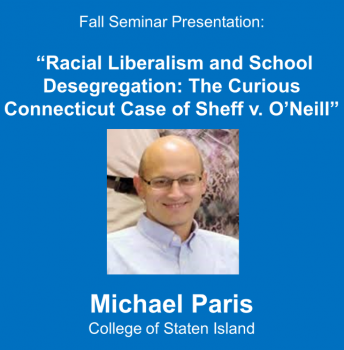Over sixty years ago, the Supreme Court, in Brown v. Board of Education (1954), determined that separating children into white and black schools was inherently unequal and that schools must integrate, “with all deliberate speed.” Despite the successes of the 1954 case, segregation based on race and class is on the rise, most especially for poor Latino students. Dr. Michael Paris, political scientist and professor of law at the College of Staten Island, presented on Thursday, October 19th at the Graduate Center, on the developments of his future book (working title), The Death and Life of School Desegregation: Racial Liberalism and American Constitutionalism. The book is based on his extensive research on the school desegregation case in Hartford, Connecticut: Sheff v. O’Neill (1996).
With the assistance of the NAACP Legal Defense and Education Fund, the Sheff v. O’Neill case originated with 18 school aged children and their parents (black, Hispanic and white) in Hartford, Connecticut. In 1989, they filed a lawsuit against the state of Connecticut (including Governor William O’Neill), citing the state had violated students’ state constitutional positive right to an equal educational opportunity, due to racial isolation and concentrated poverty. Specifically, the case cited the state spent fewer resources on public schools with majority Black/Latino populations, compared to schools with majority White populations.
The trial took 35 trial days, with testimony from 58 witnesses and some 1,000 documents of evidence. In 1995, the judge ruled in favor of the State, stating that the plaintiffs did not provide enough evidence to show that the state helped cause school segregation. One year later, in 1996, the Connecticut Supreme Court reversed the ruling and held that the state constitution “requires the legislature to take affirmative responsibility to remedy segregation, regardless of whether it has occurred de jure or de facto” (Paris, 2017). The court didn’t specify the particular remedies to be taken, but urged branches of state government to make de facto segregation a top priority. Due to the lack of specification, since 1996, the case has experienced five trips back to court, five consent decrees or agreements, several reform laws, approximately $2 billion in new expenditures and significant citywide school desegregation. The mechanism for desegregation has been voluntary for families and suburban districts, with the creation of inter-district magnet schools and a one-way urban to suburban transfer program. The result has been that by 2016, about 9,200 Hartford School District children or 45% total, attended desegregated schools, compared to 700 students or 3% in 1997. A desegregated school is defined as one in which the school population is 75% or less minority.
Professor Paris’s analysis of why Hartford has been relatively successful at integrating schools where, in other cases, integration has failed so dramatically, starts with a critique of school desegregation efforts written by the legal scholar, Dr. Derrick Bell. Bell wrote his critique in 1976 in a Yale Law Journal article entitled “Serving Two Masters: Integration Ideals and Client Interests in School Desegregation Litigation.” Bell argued that these desegregation efforts were limited in several ways. The first is about the clients in cases like this, where Bell argues that these lawsuits claim to speak for the African American community as a whole, without actually establishing that the African American community shares the same goals as presented in the case. Paris believes that Sheff addressed this issue through community engagement, buy getting buy-in from the community, and having community members give vivid testimonies. Bell also believed that the focus of desegregation cases should be better education, not an ideological commitment to desegregation, per se. Sheff took this tact as well. Additionally, Bell made clear that previous desegregation efforts had been too legalistic and reliant on the courts, when the truth is that institutions and people don’t always follow the law in a way that is productive in meeting the goal of desegregation. Sheff made great efforts to have an educational and policy aspect to its work, thus avoiding the trap of relying too much on legalistic remedies. Lastly, Bell recognized the importance of focusing not on what courts say but instead what they actually do. Sheff took this into account through a framework of of moving from “needs to rights,” drawing on a previous court victory. Additionally, Paris argues that it was very important that Hartford built some excellent magnet schools in the central city, thus incentivizing suburban parents to bus their kids into the city for school.Despite the successes of the Sheff case and its attempts to uphold students’ rights to equal educational opportunities, Dr. Paris argues that schooling for students separated by race and class can never be equal. He cited the following social conditions: high rates of joblessness, crime & neighborhood violence, single parent households & family disruptions, recurrent evictions & housing relocations and frequent incidences of health problems, developmental disabilities and hunger. Additionally, schools where students are starkly separated by race and class, generally have less prepared teachers, high dropout rates, pre-packaged curriculum, high levels of student attrition, less parental involvement and fewer resources. Hence, Dr. Paris argues that housing policy is school policy. In order to achieve equal educational opportunities for all students, it is essential to re-create housing policy, the tax code for school funding and the distribution of social resources. What type of social movement is needed to achieve such legal changes? Who are the stakeholders that need to turnkey? What is the role of students and teachers in this movement? Where do we begin?
Written by: Rachel J. Chapman and Christopher Maggio
Paris, M. (2017). Racial Liberalism and School Desegregation: The Connecticut Case of Sheff v. O’Neill (1996). Presentation presented at the Advanced Research Collective, The Graduate Center, New York, NY.





